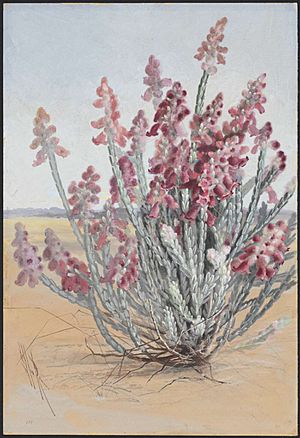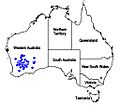Red velvet facts for kids
Quick facts for kids Red velvet |
|
|---|---|
 |
|
| Painting of H. elderi by Ellis Rowan | |
| Scientific classification | |
| Genus: |
Hemiphora
|
| Species: |
elderi
|
 |
|
The Hemiphora elderi, often called red velvet, is a beautiful flowering plant that belongs to the mint family called Lamiaceae. This special plant grows only in the south-west part of Western Australia. It's a small bush with leaves that feel soft and fuzzy, like velvet, because they are covered in white, woolly hairs. Its flowers are bell-shaped and have a lovely reddish-purple color.
Contents
What Does It Look Like?
The red velvet plant is a small shrub that usually grows to be about 30 to 45 centimeters (about 12 to 18 inches) tall. It has several branches that grow from one main stem.
Leaves
The leaves of the red velvet plant are a pale green color. They are shaped like a narrow line or a spear, but they often look almost round because their edges curl strongly inwards. Each leaf is about 10 to 15 millimeters (less than an inch) long and 3 to 4 millimeters wide. They are covered in thick, white, woolly hairs, which gives the plant its "red velvet" nickname. The top surface of the leaves can feel a bit bumpy, and the bottom surface is often hidden by the curled edges.
Flowers
The flowers of the red velvet plant grow in small, leafy groups near the ends of the branches. These groups look like short spikes and grow on fuzzy stalks.
Each flower is surrounded by special leaf-like parts called bracts, which are about 7 to 9 millimeters long and also feel woolly. There are also smaller parts called bracteoles that are 3 to 4 millimeters long. These are smooth on top but very woolly underneath.
The flower has five sepals, which are like small leaves that protect the bud. They are about 8 to 10 millimeters long and are covered in reddish-purple, woolly hairs on the outside. Inside, they are mostly smooth and are joined together at their base to form a short tube.
The petals of the flower are about 15 to 22 millimeters long. They are mostly joined together to form a tube, which is usually reddish-purple, but sometimes it can be yellow. The outside of this petal tube is hairy, while the inside is mostly smooth, except for a ring of hairs near the ovary (where the seeds will form).
The five petal parts form two "lips." The upper lip has two parts and is longer than the lower lip, which has three parts. The upper lip is about 5 to 7 millimeters long and 6 to 8 millimeters wide.
Inside the flower, there are four stamens, which are the parts that produce pollen. However, two of these stamens are sterile, meaning they don't produce pollen and don't stick out from the petal tube. The other two stamens are fertile and do extend beyond the end of the petal tube.
Flowering Time and Fruit
The red velvet plant blooms from July to November. After the flowers, it produces a fruit that is almost round, hairy, and about 3 millimeters (a tiny bit more than a tenth of an inch) across.
Plant Name and History
The red velvet plant was first officially described in 1876 by a scientist named Ferdinand von Mueller. He first gave it the name Chloanthes elderi. Later, in 1882, Mueller changed its name to Hemiphora elderi, which is what we call it today.
For a long time, Hemiphora elderi was the only plant in its group, or genus, called Hemiphora. But in 2011, three other scientists – Barry Conn, Murray Henwood, and Nicola Streiber – moved four more plant species into the Hemiphora group. These plants used to be in a different group called Pityrodia.
The second part of the plant's name, elderi, was chosen to honor Sir Thomas Elder. He was a very generous person who supported many good causes (a philanthropist) and also raised animals on large farms (a pastoralist).
Where Does It Grow?
The red velvet plant can be found in a wide area of Western Australia. It grows between places like Sandstone and Menzies in the north, down to the Parker Range and the upper parts of the Blackwood River in the south. To the east, it reaches Victoria Springs, and to the west, it can be found near Cunderdin and Lake Moore.
It grows in different types of sandy soil, including gravelly sand, on flat or gently rolling plains. You can find it in several different natural areas of Western Australia, such as the Avon Wheatbelt, Coolgardie, Great Victoria Desert, Mallee, Murchison, and Yalgoo biogeographic regions.
Is It Protected?
The Western Australian Government's Department of Parks and Wildlife has looked at the red velvet plant. They have classified Hemiphora elderi as "not threatened," which means it is not currently at risk of disappearing.
Images for kids


